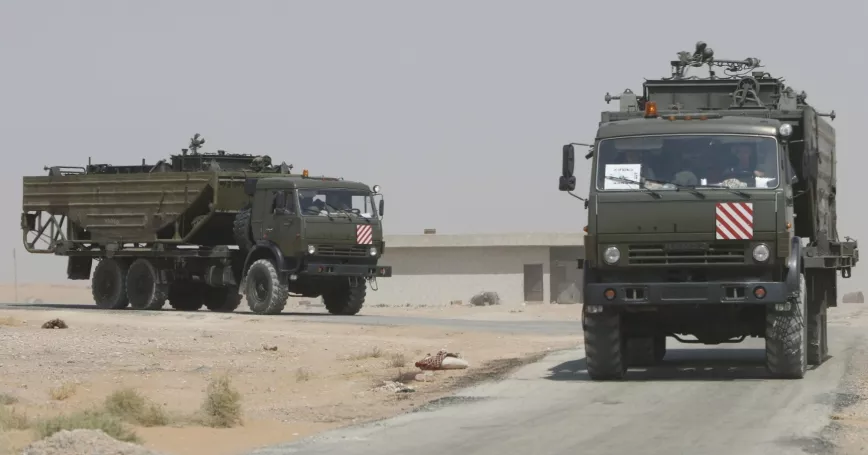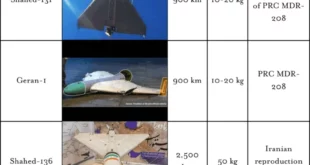A long with China, Iran, and North Korea, Russia is one of a handful of strategic competitors posing a substantial threat to U.S. strategic interests.
Russia has now interfered to some extent in at least three democratic elections in the United States. Russian hackers are probably responsible for the recent SolarWinds attack on U.S. government agency networks. Russia has been aggressively undermining U.S. interests in proxy wars in Syria, Libya, and across the African continent, and it is backing the Taliban against the United States in Afghanistan.
Russia has been taking every opportunity to undermine U.S. interests and security, while the United States has strictly limited its responses. As of early 2021, Russia appears to have the upper hand. In the wake of the Trump administration’s diplomatic rapprochement, U.S.-Russian relations may be ripe for rebalancing.
On February 4, 2021, President Biden stated “the days of the United States rolling over in the face of Russia’s aggressive actions—interfering with our elections, cyberattacks, poisoning its citizens—are over.” In defense of U.S. national interests, Biden said he would “not hesitate to raise the cost on Russia and defend our vital interests and our people.” Given this new (or perhaps return-to-status-quo) approach, how should the Biden Administration think strategically about countering Russia in global competition?
Russian leaders, diplomats, intelligence, and military officers have excelled at finding cracks in the edifices of American power. What are Russia’s vulnerabilities, and how could they be exploited to help reverse the present imbalance? How could the United States raise costs on Russia without unnecessarily raising the risks of all-out war? We argue that one of Russia’s perceived high-end capabilities may in fact be one of its most exploitable vulnerabilities.
Russia’s worst-kept secret is its increasingly heavy reliance on private security contractors—really, mercenaries—to maintain a Russia-favorable global status quo and to undermine its competitors’ interests. This reliance on mercenaries stems from a known capability gap. RAND has shown that while its military ground forces are locally dominant, Russia’s military has strictly limited ability to project ground power worldwide. It has almost no organic ability to project and sustain ground power more than a few hundred kilometers beyond its own borders. Russian strategic lift is anemic compared to Soviet-era lift. Available forces are often tied down in one of the many frozen conflicts that ring Russia’s western and southern borders.
Physical limitations on Russian ground force power projection are exacerbated by another critical weakness: Russia’s dependence on conscript servicemembers. Arguably, conscripts represent Russia’s most significant ground combat power weakness. Even a strong de facto dictator like Vladimir Putin cannot deploy one-year conscripts beyond Russia’s borders without incurring significant political risk. One of Putin’s own presidential decrees promises that conscripts will not be deployed. This decree may anchor more than 50% of Russia’s already limited ground forces to the homeland. Worse, it also undermines the ability to deploy Russia’s airborne forces (PDF)—similar to the widely deployed U.S. Army 82d Airborne Division—in roles like seizing airfields, government centers, bridges, and military bases. Unlike the Soviet Union, Russia is not a global ground combat power.
Given its ground power limitations and its predilection for deniable operations, Russia has employed heavily armed mercenaries from the notorious Wagner Group and a range of other (PDF) government-cozy (and perhaps government-run) companies as the tip of the Russian foreign policy spear. In effect, Russia has outsourced its foreign policy in Libya, Syria, the Central African Republic, Madagascar, Mozambique, Sudan, Ukraine, Yemen, Burundi, and other global hotspots.
There appears to be a symbiotic relationship between Russian special operations teams and private contract groups. Dmitry Utkin, former commander of the Russian military intelligence directorate’s (GRU’s) Spetsnaz special forces units, allegedly founded the Wagner Group in 2014. Wagner and an elite GRU Spetsnaz unit reportedly share a military base in the Russian town of Molkino. This symbiosis represents the Russian government’s tacit acknowledgment of its ground power weaknesses, and its own strategic decisions to overcome such weakness with a smaller number of special operations units and state-controlled mercenaries working in tandem.
A dominant public narrative about these small teams of mercenaries suggests they are elite, stealthy, gray-zone warriors that give Russia the ability to seize peripheral territories and beat the United States and NATO in great power competition. This narrative, which the Russians are understandably willing to let balloon beyond reason, is easily deflated. Russia is not brilliantly using little green off-the-books supermen to dominate the United States in competition.
Instead, Russia’s use of mercenaries is exposing what may be critical vulnerabilities in Russian will to fight and Russian state power. RAND’s work on will to fight—the disposition and decision to fight, act, or persevere in conflict and war—and on Russian state power suggests that Russia is using mercenaries due in great part to its inherent military and civil weaknesses. Russian mercenaries (in fact, all mercenaries) also have behavioral limitations and vulnerabilities to influence. Dependence on mercenaries also reflects a vulnerability in Russian national will to fight. Both of these weaknesses can be exploited.
Building the Myth: A ‘New Way of War’ and Little Green Men
In 2014 Russia sent a combination of unmarked special operations forces and mercenaries—and probably soldiers posing as mercenaries—into Crimea and eastern Ukraine to seize ground from the newly pro-Western Ukrainian government. This attack by what were dubbed “Little Green Men” set off waves of angst in the West, and particularly in the U.S. national security community. In the wake of the Crimea and Ukraine operations, many analysts quickly read (or re-read) a 2013 article on great power competition by Russia’s Chief of the General Staff Valery Gerasimov. Some misinterpreted (PDF) this article as a preview of a new and dangerous Russian way of stealth war.
Russia’s use of mercenaries in Syria starting in 2015 seemed to give further weight to the more dire interpretations of Gerasimov’s article. Mercenary soldiers with the Wagner Group (formerly Moran Security Group, and then Slavonic Corps Limited) and other Russian mercenary groups like Patriot, took the lead in some of the more dangerous front-line operations in Syria while uniformed Russian soldiers guarded air and naval bases along Syria’s coastline. Murky links (PDF) between Wagner’s leader, Yevgeny Prigozhin, and Russian President Vladimir Putin fed the notion that former KGB officer Putin was up to something scary.
Writers affiliated with the Kremlin helped foster the new myth of Russian ingenuity and dominance. Gerasimov’s article was mythologized in the West as the Gerasimov Doctrine. It seemed that Russia had regained its post–Cold War power and was outmaneuvering the United States and its NATO allies on every front. Russian mercenary armies were spreading out across the globe to roll back Western influence and there was little that could be done to stop them.
Debunking the New Way of War and the Mercenary Mystique
Thankfully, there were sufficient experts on Russian and Cold War history on hand to debunk the idea that this approach was in any way new or particularly threatening. Long-time Russia watcher Charles Bartles described (PDF) Gerasimov’s article as a reaction to perceived Western interference in Russian affairs, not a stealth plan to dominate the West. Russia did not invent a new way of war. The Soviet Union adopted an indirect, ambiguous, and deniable approach to international competition in the 1920s and employed it through the end of the Cold War.
Nor did Russia invent or in any way novelize the use of mercenaries. The earliest recorded use of mercenaries dates to 2094 BCE. The employment of private forces within the spectrum of both domestic and interstate rivalry has been more norm than anomaly throughout most of recorded history. The French Foreign Legion integrated mercenaries into government units (much like the current Russian approach) in early 1800s. The United States has used mercenaries in warfare and great power competition for decades. In 2017, the U.S. president reportedly considered turning over the war in Afghanistan to a private force for hire.
Mercenaries can be useful. They allow governments to employ force without obtaining buy-in from the broader public. They are often used to quietly expand the size of unpopular military deployments in places like Afghanistan and Iraq, while keeping numbers of official boots-on-the-ground low. Russia has used this quality to their advantage, expanding its worldwide footprint without extensive international public notice. Mercenaries can also be quickly hired and fired, allowing governments to rapidly expand and shrink forces without major investments in training and personnel. But mercenary forces have considerable drawbacks.
Not-So-Super Men: Syria, Africa, and Mercenary Will to Fight
In February 2018, Russian-hired mercenaries led (or at least closely accompanied) a Syrian militia force armed with artillery and heavy tanks to seize an oilfield near the city of Deir az-Zour in northeastern Syria. American Special Operations Forces and Marines decimated them with hours of precision air attacks, killing perhaps (PDF) hundreds and causing the rest of the force—including the mercenaries—to flee. As Russian-hired mercenary personnel retreated from the battlefield at Deir az-Zour, other teams of Russian private military actors had to call in helicopter teams to evacuate the wounded from the battlefield in the absence of state support.
Russian mercenaries have also performed poorly in Africa. In Mozambique, Wagner mercenaries stumbled through the kinds of partner-building efforts at which U.S. special operations forces tend to excel. They offended the locals and reportedly double-crossed allies to make money. Islamic State insurgents have successfully attacked and killed them on poorly secured roads. Mercenary disinformation tactics in Mozambique backfired. What was billed as a Russian power play in a former Soviet client state looks like a disaster in the making.
Wagner sent hundreds of trainers and security personnel to the Central African Republic to help Russian commercial interests secure mining rights and to support a complex regional diplomatic push to increase Russian influence. There has been little pretense in this operation: It is primarily a money-making venture. In one case Wagner mercenaries reportedly helped the rebels they were hired to fight in order to help a Russian mining company gain access to diamond mines. Wagner has been linked to the suspicious deaths of three journalists who were nosing around its CAR operations. This Russian mercenary-led deployment has been partially successful in countering French influence, but it is not clear that reported successes on the ground outweigh the lasting, negative consequences of Wagner’s cutthroat behavior.
Russia sent mercenaries and probably some active military forces to support Khalifa Haftar’s anti-government forces in Libya. In early 2020, 1,000 Wagner mercenaries reportedly fled the front lines between pro- and anti-government forces after suffering a resounding defeat. Combat losses for Wagner in Libya are unknown but possibly significant. The 2020 withdrawal of the equivalent of two Russian infantry battalion tactical groups in the face of relatively disorganized opponents was, arguably, a worse tactical defeat than the one suffered by Wagner mercenaries at Deir az-Zour.
One factor ties all of the Russian mercenary operations in Syria and Africa together: financial motive. Some Russian mercenaries claim that they fight for patriotic reasons. But as individuals and as a group, Russian mercenaries have repeatedly shown that they will pursue self-interest and commercial interests over state interests, and that they will quickly abandon partner forces—and perhaps each other—when the tactical risks fail to outweigh the financial rewards. A reported decision to have the Syrian government—not the Russian government—pay the mercenaries may have eroded patriotic sentiment and reinforced financial motives.
Little Green Vulnerabilities?
In 2021 the hyperbolic narrative that accompanied the 2014 seizure of Crimea and the 2015 intervention in Syria has been punctured. On their best days, Wagner and other Russian mercenary groups are at best moderately effective proxies. They are often unreliable. In at least a few cases their will to fight appeared to be poor. Given Russia’s increasing dependence on mercenaries to carry out foreign policy, this gap in will to fight may be a critical vulnerability in Russian state power. There are specific factors in Russian mercenary will to fight that can be examined for possible exploitation.
Will to fight analysis is a factor-by-factor process designed to examine and describe sociocultural, psychological, organizational, civil, and other strengths and weaknesses in a military organization or in a nation-state. The RAND military model has 29 major factors, and the RAND national model has 15 factors, contexts, and mechanisms that reveal different aspects of will to fight. One single critical vulnerability, or small set of vulnerabilities, can be exploited to degrade the will of otherwise stalwart military forces or resolute national leaders.
There is no shortage of genuine tough guys in groups like Wagner and Patriot. Under the will to fight factor of quality, many Russian mercenaries would earn high marks for fitness and resilience. But outright toughness and even elite military training alone cannot sustain the will to fight of an individual primarily motivated by money. Russian mercenaries tend to seek out this work for self-interest or clientelist reasons. Tough guys who don’t know each other and don’t trust each other’s motives are less likely to have positive cohesion, an important factor in will to fight. Reported ethnic, religious, and even national divisions within the Russian mercenary units can further undermine cohesion and suggest exploitable differences in individual ideology.
It is not clear that all, or even most of these mercenaries are all well-trained and experienced soldiers. Abuses in the Russian military system are rife, and there is evidence that some Russian mercenaries are hired off the street with no military training and no psychological preparation for combat. Some of Russia’s mercenaries are at times victims of outright exploitation and even human trafficking by the state or the companies they work for. This kind of abuse reflects bad leadership, poor esprit de corps (which has been worsened by military defeats), poor control, or discipline, and other will to fight factor vulnerabilities.
Private military actors and firms remain illegal in Russia, though they are considered legal by most other key players on the global scene. Illegality allows the Russian state to maintain deniability, and it also allows Putin and his eventual successor to cut mercenaries loose when their service is no longer convenient. Reporting in the wake of Deir az-Zour suggests that the lack of state support significantly weakened mercenary will to fight. Legal and financial battles between the state and the mercenary companies brings into question the viability of Russian civil-military relations and the impact of poor relations on the mercenary forces.
At the national level, popular unwillingness to deploy young conscripts is longstanding. During the Soviet war in Afghanistan, at least 15 (PDF) major anti-war demonstrations were held in the face of brutal security force suppression. During the conflicts in Chechnya in the 1990s and 2000, and more recently during the conflict in Ukraine, Russian mothers have openly protested the use and abuse of their children in these unpopular conflicts. Russian leaders are acutely sensitive to casualties, and historically they have been susceptible to pressure from competing states.
Together, the weaknesses within Russian mercenary forces and within the Russian state in relation to press-ganged youths, conscripts, and casualties may offer ready opportunities for exploitation in great power competition. These broader weaknesses in Russian national will to fight could be examined to identify more ways to prevent Russia from aggressively undermining Western democracy.
 Eurasia Press & News
Eurasia Press & News



